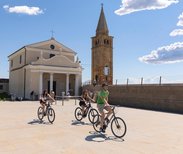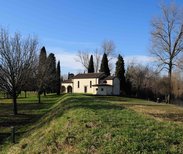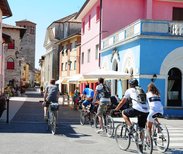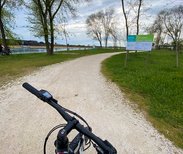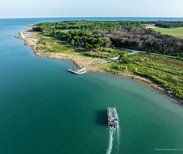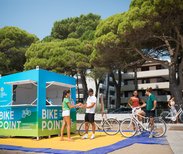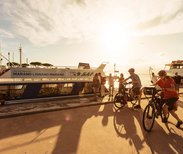The map of bike tours of Lignano Sabbiadoro and surroundings
A city route that mostly follows the town’s extensive network of bike paths, showcasing the three souls of Lignano.
In Sabbiadoro, cyclists can admire elegant Liberty-style villas, the historic seafront, and a path running parallel to the lagoon.
In Pineta, the itinerary passes by the ancient Church of Santa Maria del Mare, historic villas, and mosaics, winding through the distinctive spiral-shaped streets.
Finally, in Riviera, the route is immersed in lush Mediterranean vegetation, leading along the seafront all the way to the mouth of the Tagliamento River.
This route winds through a landscape where river and lagoon waters blend with vineyards and orchards. It begins by following the embankment along the bend of the Tagliamento River, then crosses the countryside towards Precenicco. After passing the Stella River, the path gently descends to Marano Lagunare, an ancient fishing village.
During the summer months, cyclists can take advantage of the TPL FVG public boat service between Lignano Sabbiadoro and Marano Lagunare, which allows bicycles on board. The 45-minute crossing offers a peaceful journey through the beauty and tranquility of the lagoon.
The Tagliamento, the least human-impacted river in Europe and a natural border between Friuli Venezia Giulia and Veneto, and the Stella River, which flows into the Marano Lagoon, are key elements in shaping the natural landscape of Lignano and its surroundings.
This route explores their beauty, starting along the bike path that crosses Aprilia Marittima and follows the Marano Lagoon, reaching the mouth of the Stella River and the Church of Santa Maria della Neve in the Titiano area. From here, cyclists ride through lush countryside to the Casali del Mol, then follow signs to Latisana, arriving in the town center.
The return journey takes place along the embankment of the Tagliamento River, winding through its bends in a scenic display of curves and views.
A fascinating loop trail that winds through a landscape rich in historic residences and natural scenery. The itinerary starts in Codroipo and leads to the majestic Villa Manin in Passariano, a historic residence that once hosted illustrious figures and now serves as a venue for exhibitions and events. After crossing the Corno stream, the route reaches San Martino, home to the Museum of Vintage Carriages. The journey continues through charming villages before following the course of the Tagliamento River. Upon returning to Codroipo, a refreshing stop at the Parco delle Risorgive is the perfect way to conclude the itinerary.
Grado, a charming island in the Friulian lagoon, captivates with its perfect blend of history, nature, and the sea. Also known as the "Island of the Sun", it boasts golden beaches, a picturesque historic center of Roman origin, and a relaxed atmosphere that invites visitors to wander through its narrow streets and lively squares.
This itinerary, starting from Marano Lagunare, leads to Grado, passing through places of extraordinary beauty such as Torviscosa, Strassoldo, and Aquileia. As you cycle towards the island, the landscape unfolds into shimmering waterways, canals, and salt marshes inhabited by herons and flamingos, building anticipation for the final destination.
Here, the scent of the sea blends with the aromas of the local cuisine, where fresh fish takes center stage. A place suspended between land and sea, perfect for ending the journey with a stroll through its historical treasures or a refreshing dip in its waters.
The Tagliamento Cycle Route follows the course of one of Italy’s last wild rivers, a powerful waterway that originates in the Friulian Dolomites and flows for 178 kilometers before reaching the Adriatic Sea. This itinerary explores the stretch from its mouth, between Lignano Sabbiadoro and Bibione, up to San Vito al Tagliamento, unveiling landscapes of extraordinary beauty.
Cyclists ride through lush meadows and dirt trails that climb onto the riverbanks, surrounded by thriving vegetation where alders, poplars, and white willows reflect in the water. The river ecosystem is alive, home to moorhens, mallards, and other wildlife that, with a bit of luck, may make an appearance along the way. A route that offers silence, unspoiled scenery, and the thrill of cycling in sync with the ancient rhythm of the Tagliamento.
A loop trail through the pine forest east of Bibione leads to the discovery of a natural oasis, crowned by the iconic lighthouse. The route winds between ancient coastal dunes and riverbanks covered in lush native vegetation before plunging into the heart of the pine forest. Between March and May, this landscape bursts into a spectacular spring bloom. Along the way, you may spot local wildlife, including birds, green lizards, and rare terrapins, making the experience even more immersive and captivating.
Starting from Latisana, this loop itinerary crosses the Friulian and Venetian plains, and brings us to the discovery of the reclaimed lands following the course of the Tagliamento River—an ever-present companion on many cycling routes—while passing through charming rural villages.
Among the must-see stops is the picturesque medieval village of Cordovado, listed among the "Most Beautiful Villages of Italy" and once the summer residence of the bishops of Concordia Sagittaria. Entering Veneto, the route passes through Teglio Veneto and Alvisopoli, the latter founded in the early 19th century by Venetian Count Alvise Mocenigo as an ambitious "ideal city."
The Tagliamento reappears in the final stretch, guiding the way back through San Michele al Tagliamento before returning to Latisana.
A common thread unites Caorle, Concordia Sagittaria, and Portogruaro: their deep connection with the Lemene River, which has always marked the rhythm of life and influenced the economy.
The route begins from the charming Fishermen’s Island in Caorle, following the course of the Lemene River and leading to the agricultural lands and rural villages like Ca’ Corniani. The journey continues to Concordia Sagittaria, an ancient Roman colony from the 1st century BC, and concludes in the small jewel of Portogruaro, an elegant town that Ippolito Nievo called the “Little Venice of the Mainland.”
Discover an unspoiled corner of nature, accessible from Bibione either by boat or via the cycle bridge over the Taglio Canal in the Prati Nuovi area. This strip of land still preserves the enchanting lagoon scenery that once captivated Ernest Hemingway during his hunting trips.
Cycling along Bibione’s bike paths, you can board the XLagoon boat service, which in about an hour of navigation from Porto Baseleghe reaches the Vallevecchia Nature Education Center. From there, you can continue exploring along dirt trails and, if you wish, return by following the long, straight road of Brussa and riding a stretch of the Adriatic Sea Cycle Route FVG2 back to Bibione.
Caorle is not only a renowned seaside tourist destination but also a charming fishing village with a timeless allure. Its brightly colored houses and narrow alleys evoke the picturesque atmosphere of Burano Island.
This cycling itinerary, however, goes beyond exploring the enchanting historic center: it takes you along the town’s two beaches – the wide, golden Levante Beach and the smaller, more central Ponente Beach – following the seafront and unveiling authentic spots such as the Isola dei Pescatori, home to the traditional casoni, the thatched fishermen’s huts typical of the lagoon. The route also passes by the port and the Canale dell’Orologio, which leads to the marina of the same name, offering breathtaking and evocative views.
This special itinerary, designed by Team Zerobike for the LAROSTE GRAVEL event, is a fascinating 150 km route that starts from Lignano Sabbiadoro and winds through Friuli Venezia Giulia and Veneto, along lesser-known roads and breathtaking landscapes.
The route heads inland, following the course of the Stella River up to Palazzolo, passing through the charming village of Ariis and reaching Passariano, home to the splendid Villa Manin. Skirting Codroipo, riders enter the lush Parco delle Risorgive before swiftly crossing the Tagliamento River.
The journey continues towards San Vito al Tagliamento, with its picturesque medieval center, and Sesto al Reghena, dominated by the imposing Benedictine Abbey of Santa Maria in Sylvis. Once in Eastern Veneto, the path crosses Gruaro, Portovecchio, and Boldara—water-rich lands where crystal-clear rivers and streams weave among ancient mills. Finally, the route returns to Lignano, tracing the sinuous bends of the Tagliamento River for one last immersion in nature before reaching the finish line.


